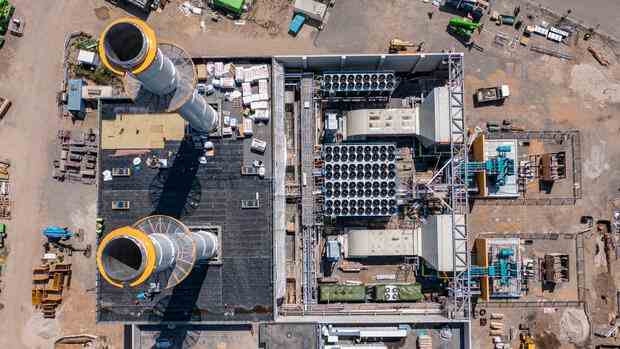High energy prices put private households and companies under pressure.
(Photo: dpa)
Frankfurt The high energy prices and the large inventories of many companies continue to ensure that German companies and the self-employed take out new bank loans on a large scale. New lending rose to a record high in the third quarter of 2022, growing 36.1 percent year-on-year. This emerges from the latest credit market outlook, which the state development bank KfW calculates exclusively for the Handelsblatt.
Although this is likely to have peaked, growth rates remain at a high level. For the fourth quarter of 2022 and the first quarter of 2023, KfW expects “continued strong but slower growth of around 28 percent and 15 percent, respectively”.
To determine new lending, KfW analyzes the changes in the loan portfolio collected by the Bundesbank on a quarterly basis and makes assumptions about scheduled repayments, i.e. loan repayments, since these must be taken into account. The KfW calculates housing loans and loans to insurers and financing institutions from the Bundesbank data.
The current KfW forecast is above the original expectations of the development bank, which has long been expecting a decline in lending business due to the impending economic downturn. “Recession expectations for the German economy have been pushed back, and with them the time when credit growth is likely to weaken,” explains KfW chief economist Fritzi Köhler-Geib.
Top jobs of the day
Find the best jobs now and
be notified by email.
The lending business with companies has developed better than that with private customers: A Bundesbank survey of banks had shown that the demand for credit from companies increased slightly in the third quarter of 2022 – while the demand for private housing loans fell more sharply than ever before since the beginning of the survey. The interest of private customers in consumer loans has therefore decreased.
“The third quarter was still characterized by high price increases for important preliminary products for companies, which drove up the demand for financing,” says Köhler-Geib. In their view, the financing needs of companies in the energy sector should also have boosted new lending business.
This assessment corresponds to data from the analysis company Barkow Consulting. According to this, the credit increase for energy suppliers in the third quarter was 21 percent, about twice as high as the general market growth. Hauke Burkhardt, Head of Corporate Finance at Deutsche Bank, explains: “Especially in July and August, the increased collateral that energy companies had to provide for their futures contracts had an impact on the financing needs of companies in this sector.”
Burkhardt confirms that the demand for loans was “also in the second half of the year significantly above the level of the previous year” – mainly because of the increased prices for preliminary products, but not only. “In addition, more companies are moving from just-in-time production to just-in-case production and are building up larger inventories of critical raw materials and other preliminary products. This is due to the experiences they have had with disrupted supply chains,” he adds.
According to his observation, what is primarily in demand is working capital loans, i.e. short-term financing for current business. In particular, loans with terms of up to one year and up to five years are in greater demand. “On the other hand, the demand for longer-term loans of ten years and more, which is common for investments, has hardly increased,” he says. The need for working capital loans was “still relatively high” in the fourth quarter of 2022.
KfW chief economist Köhler-Geib nevertheless assumes that the boom is now gradually waning. “On the one hand, the price pressure on primary products has eased somewhat, as the development of producer prices so far shows. On the other hand, the high demand is increasingly encountering more cautious banks,” she argues. Because many credit institutions now check loan applications more strictly and also charge higher interest rates.
>> Read here: Five reasons why the feared recession could not happen
This is also shown by the development of Barkow Consulting’s Corporate Credit Index. According to this, the average interest rate for five-year corporate loans in Germany has risen from around 1.6 percent to around four percent since the beginning of the year. If one compares the development of interest costs with the financing costs that banks have to shoulder on the capital market themselves, then the institutes’ interest margins have fallen.
According to the founder of the analysis house, Peter Barkow, this phenomenon is not unusual in times of rising interest rates. Part of the explanation is that many banks do not have to finance themselves on the money and capital markets, but can fall back on their customers’ savings deposits, which the institutes still only pay low interest on.
But despite the increased financing costs and the uncertain economic outlook, Deutsch-Banker Burkhardt remains optimistic for the current year: “In 2022 the focus was on working capital loans, in 2023 the need for investment financing will increase,” he says. The uncertainty still makes many companies hesitate, “but many important investments in energy efficiency and digitization cannot be postponed indefinitely”.
More: How companies save money with eco-loans.


